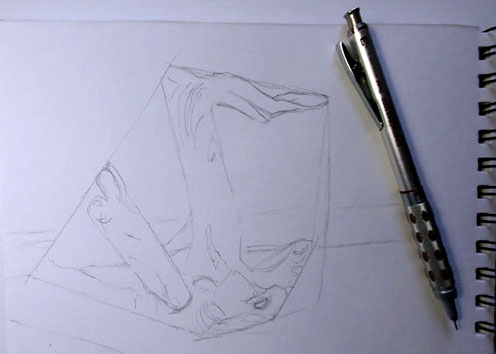Training the eye to see relationships and proportions is tough business. We tend to choose subjects based upon our current abilities and approach them with a ‘good enough’ fashion determined by limits of those abilities. This is why everyone says that portraits are the ‘hardest’ form of drawing. I see it rather tha portraits are the one place people worry about precision and accuracy.
 For myself, I’m no different but I like to challenge myself sometimes, with the most important stages of a drawing being those early stages where I’m trying to nail down relationships and proportions. Classical artists call this ‘blocking in.’ The best subjects for these exercises, for me, are those that are very organic as the relationships between one element and the others are not evident.
For myself, I’m no different but I like to challenge myself sometimes, with the most important stages of a drawing being those early stages where I’m trying to nail down relationships and proportions. Classical artists call this ‘blocking in.’ The best subjects for these exercises, for me, are those that are very organic as the relationships between one element and the others are not evident.
I found this sun-bleached stump while visiting the information center at Bic National Park, just south of Rimouski. I didn’t have time to actually draw it but I snapped this photo and it served for the exercise I’ve described.
The first thing I did was use straight lines/angles to determine the outer boundaries of each of the arms of this hunk of tree. Once this is done, double-checking the angles confirms the location of each of the arms, which will make it a lot easier to draw. I continued a bit with the pencil, drawing cylinder-shaped blobs to represent each of the arms, mostly concerned about their angles. Note that I didn’t worry much about what the actual outlines were and certainly none of the small details. I increased the contrast on this graphic so you could see the lines; in practice they are very light.
 With the location of all of the parts and their relative sizes, I can leave behind the cognitive functions of my brain, stop measuring, get “into the zone” and begin drawing with ink. It wouldn’t matter whether I was drawing “loose” or “tight,” I could draw without worrying about where the parts were supposed to be. It’s very liberating and fun.
With the location of all of the parts and their relative sizes, I can leave behind the cognitive functions of my brain, stop measuring, get “into the zone” and begin drawing with ink. It wouldn’t matter whether I was drawing “loose” or “tight,” I could draw without worrying about where the parts were supposed to be. It’s very liberating and fun.
I’m guessing here but the pencil portion took me no more than five minutes, probably less. The ink portion was more like twenty minutes. Could I do it faster if I’d skip all this and go ‘direct with pen’ as so many urban sketchers advocate. Maybe, but in my experience it actually takes longer because as a ‘direct’ pen sketch progresses, I have to ‘adjust’ things to correct for small errors I’ve made along the way. Besides, improving accuracy and precision doesn’t come from ignoring it. Besides, it’s fun. Here’s the result. It’s just a stump, but it was a fun challenge.


Nicely done, and well explained!
Thanks Todd. I don’t feel qualified to discuss art creation but find it sad that hobby artists are taught contour drawing and then, for the most part, sent along their way to “learn to see like and artist” or “improve your hand-eye coordination.
Great exercise! Thanks for the reminder.
Good artists like yourself have developed the skills to dissect proportions and relationships without a lot of underpinnings. Most hobby artists, however, have never even seen ‘blocking in’ or its rationale, which is how most good artists learned to be good artists (grin).
Great stump, Larry! Graceful drawing.
“It’s just a stump.” and yet what a lovely stump it is. I struggle with driftwood on the beach, or stumps. Though I use relative proportion with buildings and other things, somehow I haven’t totally transferred that practice to driftwood (my continuing challenge). You’ve inspired me not to give up – a stump is NEVER just a stump! 🙂 Fun exercise.
I love drawing these odd-shaped pieces of wood. I’m glad I’m not alone. I find the less you can rely upon your knowledge of shapes of the thing you’re drawing (eg – buildings are square) the more basic structural organization of a drawing helps.